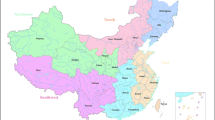Abstract
This paper discusses the constraining factors to sustainable utilization of water resources in China, and the countermeasures to realize sustainable water utilization. The result of comprehensive analysis shows that constraining factors to sustainable utilization of water resources in China are complicated, including physical geographical factors and socio-economic factors, such as uneven distribution of water resources at temporal and spatial scales, inappropriate institutional arrangement and non-water-saving and non-water-conservation production and life mode. The countermeasures against constraining factors to water resources sustainable development are put forward as follows: 1) using wetlands and forests, and through spatial conversion to realize temporally sustainable supply of water resources; 2) transferring water between basins and areas and developing various water resources in water shortage area; 3) establishing water-saving society; 4) strengthening water pollution control and water resources protection; and 5) establishing unified water resources management mechanism.
Similar content being viewed by others
References
CHEN Yi-yu, CHANG Jian-bo, 1995. Wetlands loss and alteration of the floodplain in the lower and middle reaches of Yangtze River[A]. In: CHEN Yi-yu (ed.). Study of Wetlands in China [C]. Changchun: Jilin Sciences & Technology Press, 153–160. (in Chinese)
DENG Wei, BAI Jun-hong, YAN Min-hua, 2002. Problems and countermeasures of water resources for sustainable utilization in China[J]. Chinese Geographical Science, 12(4): 289–293.
DENG Wei, SONG Xin-shan, ZHAI Jin-liang, 2000. Wetland protection and sustainable utilization of water resources in the flooded area [J]. Science and Technology Review, (3): 58–60. (in Chinese)
FENG Shang-you, 2000. Introduction to Water Resources Sustainable Development and Management [M]. Beijing: Science Press, 8–11. (in Chinese)
LI Wen-hua, 1999. Flood of Yangtze River and ecological restoration[J]. Journal of Natural Resources, 14(1):1–8. (in Chinese)
Nanjing Institute of Hydrology and Water Resources, Office of State Flood Control and Drought Relief Head quarters, 1997. Chinese Flood and Drought Calamity [M]. Beijing: Chinese Water Conservation and Water Power Press. (in Chinese)
State Environmental Protection Administration of China, 2001. Bulletin of Chinese Environment Status Quo in 2000[Z]. Beijing: State Environmental Protection Administration of China.
ZHAI Jin-liang, HE Yan, DENG Wei, 2000. Flooding and floodplain sustainable development in China [J]. Chinese Population, Resources and Environment, 10(Special issue):46–48. (in Chinese)
Author information
Authors and Affiliations
Additional information
Foundation item: Under the auspices of the Knowledge Innovation Program of Chinese Academy of Sciences (KZCX2-SW-317)
Biography: ZHAI Jin-liang (1975–), male, a native of Shandong Province, Ph. D., specialized in water and soil resources and environmental research
Rights and permissions
About this article
Cite this article
Zhai, Jl., Feng, Rg. & Xia, J. Constraining factors to sustainable utilization of water resources and their countermeasures in China. Chin. Geograph.Sc. 13, 310–316 (2003). https://doi.org/10.1007/s11769-003-0035-2
Received:
Issue Date:
DOI: https://doi.org/10.1007/s11769-003-0035-2




